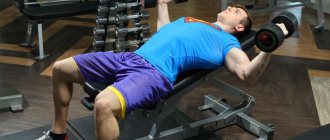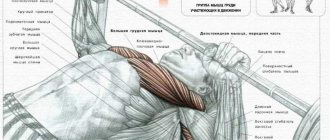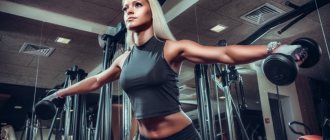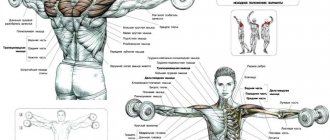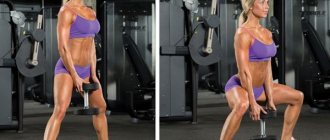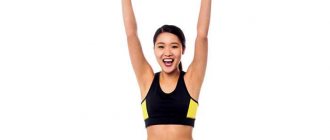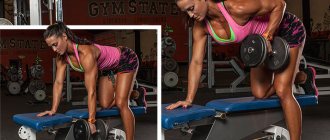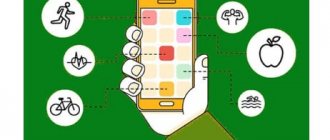20.07.2020
| no comments
Dumbbell flyes lying on a horizontal bench are an isolating exercise that is aimed at working out the athlete’s pectoral muscles in detail and increasing their volume. The athletes of the “old” guard (Arnie, Franco Colombo, Larry Scott, etc.) were very fond of the fly.
It was thanks to her that they achieved a beautiful contour of the pectoral muscles, an increase in lung volume and good muscle stretching. Nowadays, more and more young strength athletes forget about this wonderful exercise, replacing it with various exercises in simulators (Pek-Dek simulator, for example).
What muscles work?
Although the dumbbell fly is an isolated exercise for working the pectoral muscles, it also involves other muscle groups:
Muscle synergists:
- pectoralis major;
- anterior bundle of deltoid muscles;
- the short head of the biceps brachii muscle (in common parlance, the biceps).
Stabilizer muscles:
- triceps;
- press;
- brachialis;
- wrist flexors.
Pullover with a dumbbell lying on a bench with only the upper back
And now we are back to anatomy again. Look at the anatomical structure of the back in the picture below. The trapezius muscle is indeed shaped like a trapezoid, at least when you consider the right and left muscles together as one. Individually, they have the shape of a triangle and are quite large in size.
- upper - raises the shoulder and straightens the neck;
- middle - brings the shoulder blades together;
- lower - lowers the shoulder blade down.
The fact is that most people think of the trapezius as 2 small muscle strips located at the base of the neck, and this is just the part that can be pinched. They are usually very large on halfbacks in rugby. But these so-called little muscle strips are just the tip of the iceberg.
To make your trapezius grow, you need to train the entire muscle group, focusing on training the lower part as well. But shrugs don't do that. You can only feel the strain on your lower trapezius if you stand straight and pull your shoulders back. Now lower your shoulders, while the lower part of the trapezius muscle pulls the shoulder down. And one of the best exercises for training the lower part is
The lower trapezius contracts to stabilize the shoulders and lower them, making it possible to lift the weight overhead. There is another option for performing this exercise.
Now let's turn our attention to training the middle part. To do this, exercises are performed to retract the shoulder blades.
Let us remind you once again that the upper part of the trapezius is a small part of the entire muscle. Shrugs only train the upper part when performed in a vertical plane. At least that's what most of them do. Usually they hold dumbbells like in the picture below. Or use a barbell. In any case, the movement occurs in one plane - up and down.
The shoulders are almost always pointed (rounded) forward. This is why most guys don't see any benefit from doing shrugs other than strengthening their grip (increasing hand strength). In addition, poor posture develops. Retracting the shoulder blades is one of the main functions of the trapezius muscles. This doesn't mean dumbbell or barbell shrugs are a bad exercise, but they need to be done differently.
We discussed the retraction of the shoulder blades, but there is also a reverse process - extension. As in the same analogy with a cat's paw. The shoulder blades retract when we try to connect them and extend when we relax and allow them to separate. When the shoulders move forward, they move apart, and when they move back, they connect.
If the shoulders are down, the trapezius muscle is in the eccentric phase (most stretched, elongated). When the shoulder joints are at the lowest point of the movement, they do not need to be rounded forward, but should be allowed to drop all the way down. Research has shown that the eccentric part of the exercise (this applies not only to shrugs) is as important for muscle growth as the muscle contraction itself.
You can read about it here - what is muscle soreness for? It is also known that loaded stretching is very effective for stimulating muscle hypertrophy. In short, it is best to perform shrugs and other trap exercises with a slow, controlled release of the weight in the eccentric phase and allow the muscle fibers to fully stretch.
Let's look at the example of a shrug with dumbbells or a barbell. First, we lift the weight up and back (as discussed above), and then, along the same trajectory, we lower it down. When the lowest point of the exercise is reached, maximum stretching of the muscle fibers occurs (the limit of the eccentric phase). At the same time, the scapular bones also extend and diverge to the maximum. Pause at this point for 1 second before the next repetition. Training in this mode will lead to results quite quickly.
This version of the pullover belongs to the respiratory group. Efficiency does not depend on increasing the load, but on good stretching of the pectoral muscles and proper breathing.
It is advisable for beginners to use the services of professional trainers to master the technique. In the future, the exercise will be performed “automatically.”
In this case, it will be possible to properly stretch the spine and pectoral muscles. In this case, it is especially important to adhere to the correct execution technique. Otherwise there is a risk of injury. For convenience, it is worth using the services of a partner who can always give or pick up a dumbbell if necessary. It is desirable that he himself has the required skills and knowledge so that he can point out mistakes and suggest how to do it correctly.
How to do the pullover chest exercise correctly while lying on a bench with your upper back? The technique is as follows:
- Lie with your shoulders on the bench, bending your knees and placing your feet on the floor.
- Take a dumbbell in your hands and place it in front of your chest.
- Slowly lower it behind your head, as in the previous version. Since your back is not completely on the bench, your body will feel like it is being pulled down behind your head. As a result, the back muscles will stretch as much as possible.
- Also slowly raise your arms, returning to the starting position.
It is important to perform the exercise smoothly, without making sudden movements, so as not to get injured.
This version of the exercise can only be mastered by experienced athletes, since doing it is much more difficult than on a flat surface. In this case, the tension in the pectoral and latissimus dorsi muscles is strongly felt. In addition to the fact that it is much more difficult to perform the exercise when bending the body down, the risk of increasing blood pressure increases. Therefore, people suffering from hypertension are not recommended to do a pullover in this way. Sometimes capillaries can burst due to excess load.
In fact, the technique of performing the pullover exercise while lying on an incline bench is not too different from the previous options:
- Lie down on an incline bench. In this case, the head is below the level of the legs.
- Take a dumbbell in your hands and place it in front of your chest.
- Slowly lower your hands behind your head, and then return to the starting position.
As you inhale, the arms lower, and as you exhale, they rise.
Given the specifics of the exercise, it is not recommended to use a dumbbell that is too heavy.
- We sit across the bench, hold the apparatus vertically on our knees, and lie down. We rest our heads against the edge of the bench and hang our heads. To increase the load on the chest, lower the pelvis down slightly, avoiding oscillatory movements up and down. It is better to bend over when placing the projectiles towards the back of the head.
- With arms half bent at the elbows, along the trajectory of the arc, we pull the dumbbells behind the head, lowering them until the latissimus and pectoral muscles contract.
- When the torso and body are on the same line, we hold the projectiles for a second, then return the arms to the starting position.
In the exercise, the upper trapezius, rhomboid and levator scapulae muscles are subjected to heavy load and maximum contraction. This technique allows you to avoid “sagging” your shoulders forward by bringing your shoulder blades closer together.
- Place the bar on the racks at the level of your buttocks, turn your back to the bar.
- Take an overhand grip slightly wider than shoulder width, with the back of your hand facing forward.
- Carefully remove the barbell by taking a step forward.
- Place your feet hip-width apart and move your shoulders back. Don't round your back.
- As you exhale, raise your shoulders to your head as much as possible, feeling a burning sensation in your trapezius.
- Lower your shoulders and stretch your muscles as you inhale.
Important! Choose the correct weight of the barbell; the weight should not overweight and tilt the torso back, overloading the lower back.
By performing shrugs while lying on your stomach at a 45-degree angle, you can train your upper trapezius as well as your upper back. The exercise will help develop correct posture. This option significantly relieves the load on the lower back and legs.
- Lie on an incline bench with your stomach down. Take the dumbbells from the stands for convenience.
- Stretch your traps in the lower position. Arms with dumbbells are straight.
- As you exhale, raise your shoulders as high as possible, bringing your shoulder blades towards each other, and hold for a second at the peak of the contraction.
- As you inhale, lower your shoulders.
Each person is a person with individual taste and his own characteristics, so you need to select dumbbells to suit your needs. These tips will help you choose:
- Functionality. It is important to know that for optimal physical development you need to start small and take steps forward. It is useful to be able to increase and decrease the weight during dumbbell training at home, this is possible due to the number of weights on the bar. An important component of dumbbells are the weight plates. They are available in almost any weight, starting from 0.1 kg. We recommend pancakes weighing from 0.5 kg to 2 kg.
- Convenience is the key to successful training. Having chosen beautiful but uncomfortable shoes, it is very difficult to feel free and ready for achievements. Let's draw an analogy with sports. The equipment will be good if it suits you personally. Dumbbells must be made with high quality, and this is manifested in the covering of the bar with rubber or notches that help to hold the equipment during training.
- A less important point is the appearance of this device. Exercises with dumbbells for women are why you need beautiful bright equipment. They should inspire a desire to work on oneself, and for some, a color that is pleasing to the eye will also be important.
Execution technique
Preparation of the workplace:
Select a horizontal bench and adjust its height so that the thigh is parallel to the floor, and with your knees bent, a right angle (90 degrees) is formed.
Make sure that the safety locks on the dumbbells are tightly tightened to avoid unpleasant injuries. Then place them on the sides of the bench.
Performance:
1) Sit on a bench and place your feet firmly on the floor. Using body strength, lift the dumbbells onto your hips;
2) Slowly lie down on the bench and at the same time, as you exhale, straighten your arms with the dumbbells up. Then you need to stabilize the body: bring your shoulder blades towards your spine and bend your lower back;
3) Bend your elbows slightly; they should not be completely straight. Palms should face each other. This will be the starting position;
4) Begin slowly, feeling a thorough stretch in the pectoral muscles, lower your arms until your forearms are parallel to the floor;
5) Exhaling, sharply contracting the pectoral muscles, return the dumbbells to their original position;
6) Hold the peak contraction for 1 second, then repeat the movement until the end of the exercise.
Errors during execution
Using excessive weights.
I advise those who like to stroke their vanity and show off their huge dumbbells in front of the people to think 100 times. This is not an exercise where you should grab onto everything. Before increasing working weights, you need to work out the correct technique. Then achieve the desired physical shape, and then increase weight. Otherwise, the heavy weight will force you to bend your arm at the elbow and it will experience monstrous loads. As a result, you can get injured, which will ruin your training forever.
Straightening your arms while doing the exercise.
Straightening, just like bending the arms, transfers the entire load to the elbow joint. Plus, with straight arms it is much more difficult to hold the weight of dumbbells, especially when raising them to the sides. This can cause your arm to be pulled or broken. But do not forget that the shoulder will experience a lot of pressure and can also be injured. Therefore, make sure that there is always a slight bend in your elbow!
Don't use inertia.
In any exercise, the main thing is to control the entire process of its implementation. Lying lateral raises are no exception. Treat dumbbells with care, as if you were lifting children. There is no need to throw them sharply down and then push them up by inertia. Firstly, the exercise technique will suffer greatly. Secondly, you do dumbbell flyes and not swings. And thirdly, you can injure your shoulder or stretch your chest muscles.
Here, in principle, are all the main points that are worth remembering so that the training goes smoothly and productively. Learn the technique of performing the exercise. Practice with light dumbbells for a few weeks until you perfect it to the point of proficiency. And after that you can work on the progression of loads. There is a video at the end showing the correct technique.
Useful tips
No. 1. Lying dumbbell flyes must be performed slowly, observing the correct technique. Learn to focus on stretching and contracting muscle fibers;
No. 2. Do not hold the dumbbells at the top point for more than 2 seconds;
No. 3. Try to minimize the dumbbells touching each other;
No. 4. Do not allow the dumbbells to be too close to the body, use a wide semicircle of movement;
No. 5. Find a comfortable position for yourself with dumbbells at the bottom of the exercise, feel that wonderful feeling of stretching.
Exercise technique
Let's look at how to properly perform the negative and positive incline exercise.
Dumbbell flyes while sitting on an incline bench upside down
So, as we said earlier, in this variation we focus on the upper pectoral muscles.
When flattening, do not hit the dumbbells against each other.
Technique:
- We set the bench at an angle of 15 to 30 degrees.
- We place dumbbells next to the bench on the sides.
- We sit on the edge, lift the dumbbells and place them on our hips.
- At the same time pushing the projectile towards you with your feet, we lie down on the bench.
- We have dumbbells in our bent arms near our chest.
- We exhale and take the starting position, that is, we raise our outstretched arms up. Elbows should be slightly bent.
- Now we begin to perform the exercise - we inhale and spread our arms to the sides, but only the shoulder joints should participate in the movement: the hand and forearm do not move.
- At the bottom, you should feel a good stretch in the pectoral muscles and front deltoids. But don't lower the dumbbells below your shoulder line.
- As you exhale, bring your hands together again, without the dumbbells touching each other.
Do not straighten your arms at the bottom. This will put undue stress on your elbow joint.
The exercise can be performed 20 times in 2-3 approaches. Remember that if you are working on mass, you need to choose higher weights and fewer repetitions, if you are working on weight loss or just giving relief, you need to choose lower weights and more repetitions.
Video: Lifting dumbbells in a positive inclination while lying down
Dumbbell flyes on an incline bench upside down
To perform this exercise, it is most comfortable to use an abdominal bench. The angle of inclination in it is usually adjustable.
Head-down flyes are easier than sitting upside down
Technique:
- If you are doing the exercise with heavy dumbbells, you will need help picking them up.
- If the projectile is not very heavy, then we take it ourselves and sit on the bench.
- Typically, an incline bench has two bolsters: one under the knees, the other above the shins.
- Having fixed your legs comfortably, we lie with our backs on the bench so that the shoulder blades, buttocks and hips are pressed to the surface, and a slight natural deflection remains in the lower back.
- We bring our hands with dumbbells up. We hold dumbbells not above our heads, but directly above our chests.
- As we inhale, we spread our arms to the sides, as in the previous version, without involving anything other than the shoulder joint in the work.
The seated dumbbell raise exercise is not basic, but isolated. This means that there is no need to wait for strong muscle growth. It is used to stretch, warm up, tone and shape the pectoral muscles. That is why performing it with heavy weights is not very advisable.
Use medium to light weights, but do more reps—12 to 20 in 2 to 3 sets.
Video: Negative Incline Dumbbell Flyes
Errors
No. 1. Most young athletes make a huge mistake: instead of doing dumbbell flyes, they do bench presses. You need to understand and feel the difference between a dumbbell press and a fly.
No. 2. I already said above that when performing the exercise you should not keep your arms completely straight. This can lead to elbow injuries and torn ligaments.
No. 3. Keep your head down! “Glue” the back of your head to the bench until you finish the exercise. Osteochondrosis of the cervical spine is not a good prospect.
#4: Don't lower the dumbbells too quickly. Otherwise, you will not see any benefit from the exercise, and there is still a risk of injuring the pectoral muscles.
No. 5. Do not put your feet on the bench. The legs provide you with stable support when performing the fly.
Application
Dumbbell flyes lying on a horizontal bench are performed after pressing exercises (barbell press, dumbbell bench press, dips, push-ups).
The main essence of the fly is to stretch the muscles after power presses. It is not advisable to take heavy dumbbells.
Personally, I perform 4 sets of 12-15 reps on each chest workout, while switching from a flat bench to an incline bench.
That's all, dear athletes, good luck!
Working muscles
Before performing dumbbell flyes while lying down, the athlete needs to know which muscles work.
Basic
This isolated exercise trains the chest muscles, because in the process they are stretched in length and give the muscle fibers a significant distance to contract. This is precisely the reason for the growth of muscle mass, because the more the muscles contract, the more fibers work. When performing exercises, the practitioner should feel the chest stretching. This is not the case when you need to lift heavy weights and strive to set records; it will be more effective to work on technique and concentrate on training a specific muscle group and how you feel. During training, tears appear in the muscle fibers; their recovery always takes time. When an athlete rests, the amino acids and proteins that are included in the products envelop the damaged fibers, as a result of which they are not only restored, but also become more voluminous. The recovery process is fastest in the triceps, slowest in the back.
Did you know? Ronnie Coleman (bodybuilding legend, eight-time winner of the Mr. Olympia competition) used dumbbells weighing 30 kg during pumping training.
If the main load falls on the central part of the pectoralis major muscle, then the anterior deltoids, serratus anterior and coracobrachialis muscles become the assistant muscles. Also a pleasant addition will be the effect of the exercise on the formation of correct posture, the development of chest width and high-quality stretching of the back.
Important! You cannot lower your legs to the floor; you need to leave them bent at the knee joints so that your feet rest against the edge of the bench. This is necessary in order to avoid involuntary arching in the lower back. Such a deflection, even if insignificant, will remove the load from the pectoral muscles and take it to the lower back, which will significantly reduce the effectiveness of the exercise.
Bench press
First, let's study the technique of performing a classic bench press, on a horizontal bench, with a barbell, what a rack is - this is a platform, 2 racks on the right and left sides, on which there are clamps to put a barbell with weight, and take the bar with the desired heights, each athlete has different arm lengths, so there are usually 3 lifting heights.
Body position is the first moment for taking the barbell from the rack, you must lie down so that your eyes look directly at the bar, this is the correct option for taking it, then with or without an assistant, you must straighten your arms, then with or without an assistant, set it along the chest line, it is advisable to do each approach, repetition, with a coach or partner, on the bench press, for insurance, there are cases when muscle failure occurs and the bar suddenly falls on the chest or face, so it is always better to play it safe so as not to get injured. The bar should fall strictly on the chest, no higher, no lower, to the level of the nipples, and rise to one point.
Weight and option
Beginning athletes have a hard time choosing the optimal weight for exercise and setting the bench at the correct incline. When performing, you need to do a warm-up approach to activate the desired muscle group. Typically this is 10-15 repetitions.
Warm-up weight for men can be from 5 to 7 kg, for women - 2-3. Warm-up is performed before horizontal wiring. Thanks to this, you can avoid stretch marks. The ideal weight for work will be the one with which the last two or three repetitions are difficult.
To gain mass, dumbbell flyes should be done in 4-5 sets with 10-15 repetitions. When drying, the number of repetitions should be greater. To strengthen your chest, you need to perform exercises with medium weights. As for choosing the incline of the bench, it depends on what muscles will be pumped in the process.
Lying dumbbell fly
We lie on a horizontal bench. Arms with dumbbells are extended upward and slightly bent at the elbows. The back of the head is pressed tightly against the bench. The legs rest firmly on the floor, the buttocks are tense.
How to perform dumbbell flyes while lying down
Dumbbell flyes lying on a horizontal bench. Start.
Dumbbell flyes lying on a horizontal bench.
Finish. Smoothly move the dumbbells straight to the sides. At the same time, do not bend your arms too much so as not to turn the dumbbell fly into a bench press. If you cannot raise the dumbbells without noticeably bending your arms, then the weight is too heavy. Lower the dumbbells as low as possible. Feel a pleasant stretch in your chest muscles. Then, as you exhale, smoothly return the dumbbells to their original position along the same path. Don't linger at the top and start moving the dumbbells out to the sides again. Complete the required number of repetitions.
Breath
When raising your arms with dumbbells to the sides, take a deep breath, when bringing them down, exhale.
The weight of the dumbbells in this exercise should be one and a half to two times less than with the dumbbell bench press.
Butterfly load
Performing flyes in the simulator is considered to be the same effective option for pumping muscles as a standard dumbbell fly while lying on a bench at an angle. An isolated option for loading the middle part of the pectoral muscle is considered popular among women.
Thanks to regular exercise, you can pump up your pectoral muscles and make them expressive. This method is convenient thanks to the block system. If the standard dumbbells do not fit, then they need to be changed. But here it’s enough just to move the pointer on the load and perform the exercise again.
By changing positions, you can pump up the muscles of both the chest and back. As for the execution technique, doing something wrong is simply unrealistic. The simulator is easy to use. But if we talk about efficiency, then raising dumbbells at an angle of 45 degrees will give a better result than a butterfly.
Bench location
If the bench is located horizontally, then the load is focused on the middle of the body, on the lower part of the pectoral muscle. The arm muscles will also work in the process. Lying dumbbell flyes are considered an effective exercise for expanding the chest surface. It is used by both men and women.
If the head is at a level higher than the legs, then the load falls on the upper chest. Here you can take more weight, this will help pump up the muscles faster. The repetitions are performed slowly so that the body feels the load.
In the case when the end of the bench is lowered down, the muscles of the pectoral groups are worked out. Therefore, the answer to the question of which muscles work in an angled dumbbell fly depends on the location of the bench. In this case, novice athletes need to consult a coach.
